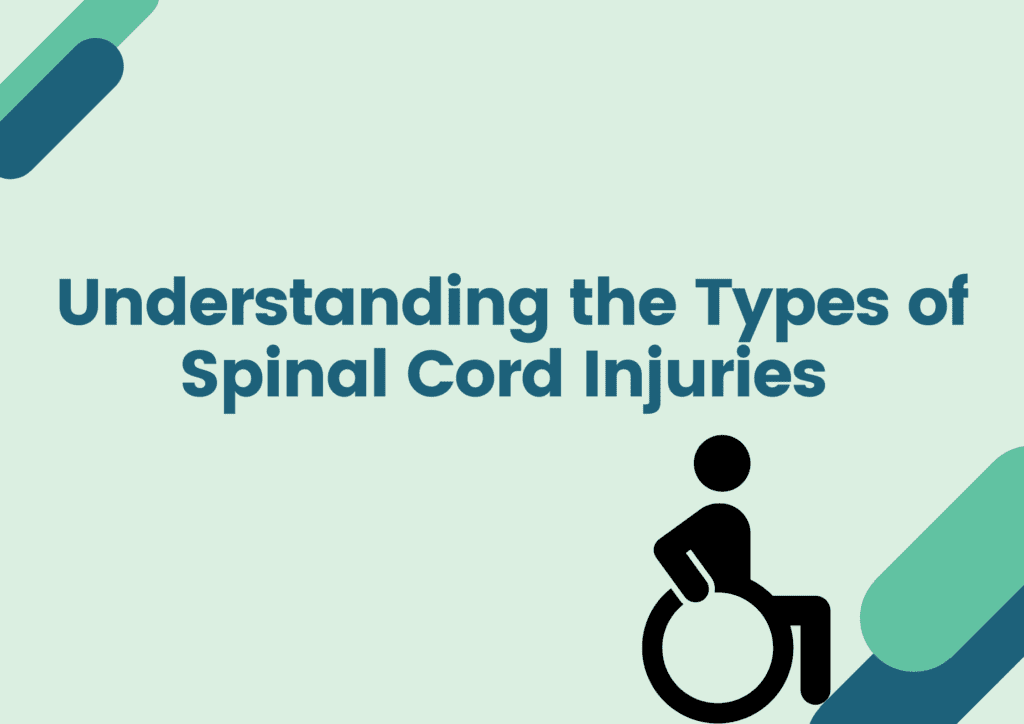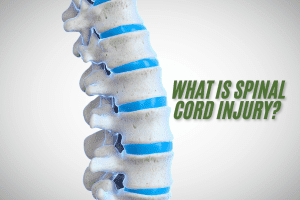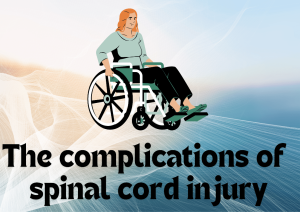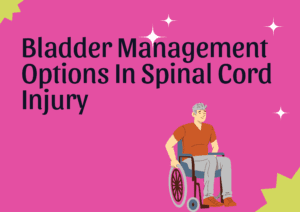
By Scihealthhub – September 10, 2024
Spinal cord injury (SCI) can be devastating and life-disrupting, affecting many aspects of a person’s physical and emotional well-being.
Understanding the different types of spinal cord injuries is important for anyone affected by or interested in this health condition.
In this article, we will explain the types of spinal cord injuries in simple terms, making it easy for everyone to understand.
But first, let’s do a brief introduction of spinal cord injuries.
Introducing spinal cord injuries
The spinal cord together with the brain make up the central nervous system. Both organs receive, send, process and interpret information from the entire body.
The spinal cord is a long bundle of nerves that carries messages between the brain and the rest of the body. It is housed and protected by rings of bones called vertebrae.
It is like a communication highway between the brain and the rest of the body.
When the spinal cord is injured, the communication highway is damaged. This can disrupt the flow of messages between the brain and the body, leading to a wide range of symptoms depending on the severity and location of the injury.
The symptoms of spinal cord injury can include:
- Loss of movement or sensation in parts of the body (paralysis)
- Weakness
- Abnormal sensations like numbness or tingling
- Difficulty controlling bladder or bowel functions
- Pain or discomfort
You may like to read the article what is spinal cord injury for more on the workings, symptoms, causes, risk factors and prevention of spinal cord injuries.
How the spinal cord is organized
The spinal cord is organized into 31 segments, each of which sends nerve roots out into the body, carrying signals to and fro the body.
Each segment corresponds to a specific vertebral level and is responsible for controlling specific functions.
The 31 segments of the spinal cord are grouped into 5 regions as follows:
- Cervical: The neck area contains 7 cervical vertebrae (C1 through C7) and 8 cervical nerve segments (C1 through C8)
- Thoracic: The chest area contains 12 thoracic vertebrae (T1 through T12) and 12 thoracic nerve segments (T1 through T12).
- Lumbar: The lumbar area (between the chest area and the pelvis) contains 5 lumbar vertebrae (L1 through L5) and 5 lumbar nerve segments (L1 through L5)
- Sacral: The sacral area (from the pelvis to the end of the spine) contains 5 sacral vertebrae (S1 through S5) and 5 sacral nerve segments (S1 through S5).
- Coccygeal: The tailbone area contains 1 coccygeal nerve segment.
These segments work together to enable the spinal cord to process and transmit vital information between the brain and the body.
What are the types of spinal cord injuries?
There are 2 ways of describing the types of spinal cord injuries.
First, is based on ‘the completeness’ (how much feeling and movement the person has left) of the injury, in which case we have two main types:
- Complete spinal cord injuries, and
- Incomplete spinal cord injuries.
Second, spinal cord injuries can also be described based on the level of the spinal cord (segment) where the damage occurred, in which case we can have:
- Cervical spinal cord injuries
- Thoracic spinal cord injuries
- Lumbar spinal cord injuries
- Sacral spinal cord injuries.
Let’s now explain these different types of spinal cord injuries one after the other.
1. Complete Spinal Cord Injuries
A complete spinal cord injury is one where there is a total loss of sensation and movement below the level of the injury. In other words, the spinal cord’s ability to send and receive signals from below the injury site is completely lost.
Loss of feeling and loss of movement is known as paralysis. Paralysis from a spinal cord injury can occur in 2 forms:
- Quadriplegia (Tetraplegia): here, the injury affects the cervical (neck) region of the spinal cord, leading to paralysis in all four limbs (both arms and legs) and the trunk. It can also affect muscles that control breathing and other bodily functions.
- Paraplegia: This occurs when the injury is in the thoracic (upper back), lumbar (lower back), or sacral (pelvic) regions. Paraplegia typically results in paralysis of the legs and lower part of the body, while the arms remain unaffected.
2. Incomplete Spinal Cord Injuries
An incomplete spinal cord injury means that some feeling and movement remains below the level of the injury.
There are several types of incomplete spinal cord injuries depending on the extent and location of the damage.
Here are some common categories:
- Anterior Cord Syndrome: the damage affects the front portion of the spinal cord. It often results in the loss of movement and some sensation, particularly pain and temperature sensation, but may leave other sensations like touch intact.
- Central Cord Syndrome: this results from damage to the centre of the spinal cord, typically in the cervical region (neck). It leads to greater impairment in the arms than in the legs. This condition might allow some degree of walking, but the individual may have significant difficulty with arm and hand movements.
- Brown-Séquard Syndrome: occurs when one side of the spinal cord is damaged. It can cause loss of movement on one side of the body, and loss of sensation on the opposite side.
- Posterior Cord Syndrome: the damage happens to the back part of the spinal cord. It leads to loss of proprioception and vibration sensation below the injury, while movement and pain and temperature sensation remain relatively intact.
- Conus Medullaris Syndrome: the damage happens to the lowest part of the spinal cord (conus medullaris). It affects bowel, bladder, and sexual functions and may cause lower limb weakness.
- Cauda Equina Syndrome: the nerve roots below the spinal cord (cauda equina) are damaged. Symptoms include severe lower back pain, weakness and loss of sensation in the legs, and abnormal bowel or bladder function.
- Incomplete Tetraplegia/Quadriplegia: Partial damage to the spinal cord in the neck region, affecting all four limbs.
- Incomplete Paraplegia: Partial damage to the spinal cord in the thoracic or lumbar region, affecting the legs.
3. Spinal Cord Injury Levels
The specific effects of a spinal cord injury depend not only on whether the injury is complete or incomplete but also on the level (segment) of the spinal cord at which the injury occurs.
- Cervical (Neck) Injuries (C1-C8): These are the most severe types of spinal cord injuries because they are closest to the brain. Injuries at this level can result in quadriplegia, where both the arms and legs are affected. Higher cervical injuries (C1-C4) can cause breathing difficulty.
- Thoracic (Upper Back) Injuries (T1-T12): Injuries to the thoracic region typically result in paralysis in the legs (paraplegia) and trunk, with the arms unaffected.
- Lumbar (Lower Back) Injuries (L1-L5): Lead to some degree of loss of function in the hips and legs. People with lumbar injuries usually retain control over their upper body and may still have some movement in their legs.
- Sacral (Pelvic) Injuries (S1-S5): Can affect the hips, legs, and pelvic organs. However, they are less likely to cause paralysis in the legs compared to injuries higher up in the spinal cord.
In conclusion, spinal cord injuries are complex and diverse, ranging from complete to incomplete, and varying in severity and impact. Understanding the unique characteristics of each type, is essential for appreciating the challenges faced by those affected and for knowing the kind of support and treatment they might need.
If you found this post helpful, please subscribe to our newsletters and follow our social media handles. Feel free to drop a comment also.






